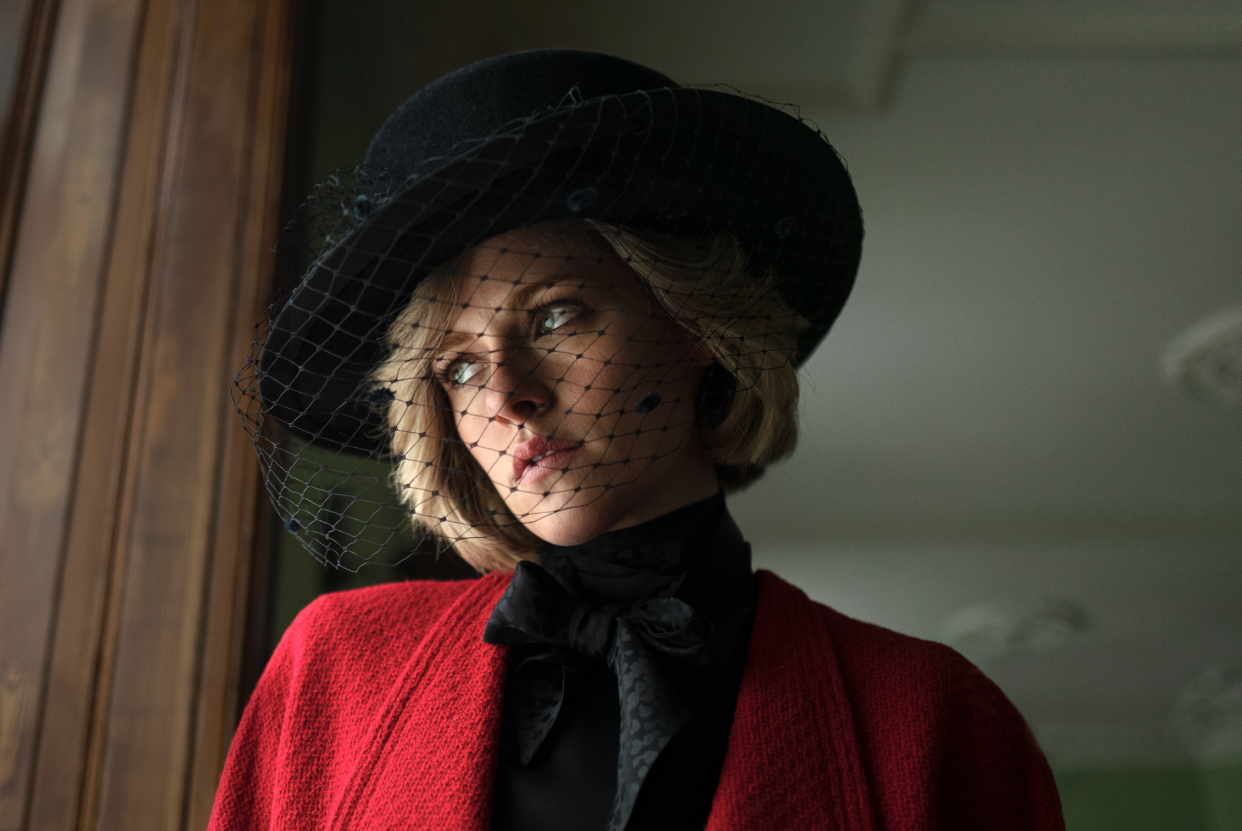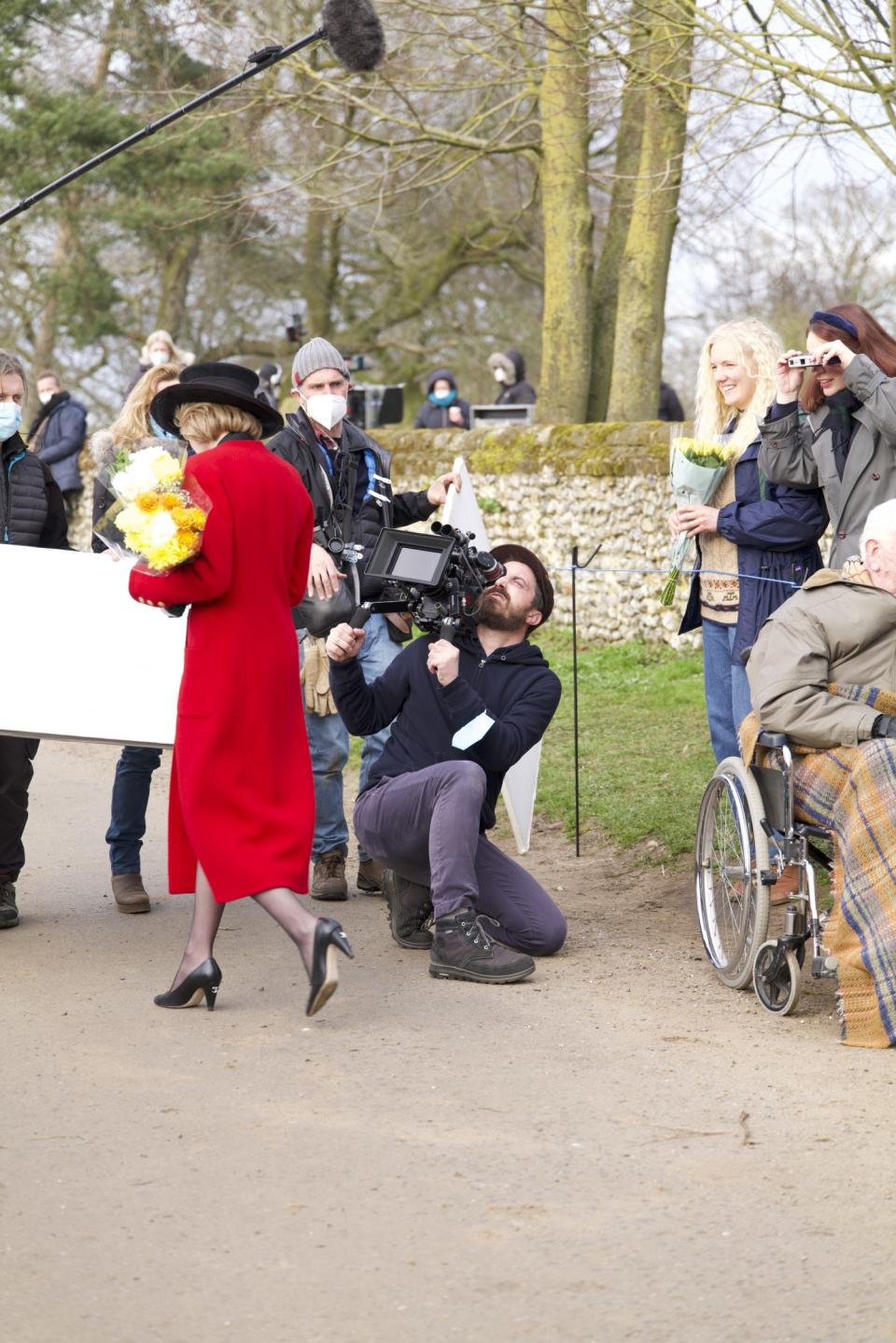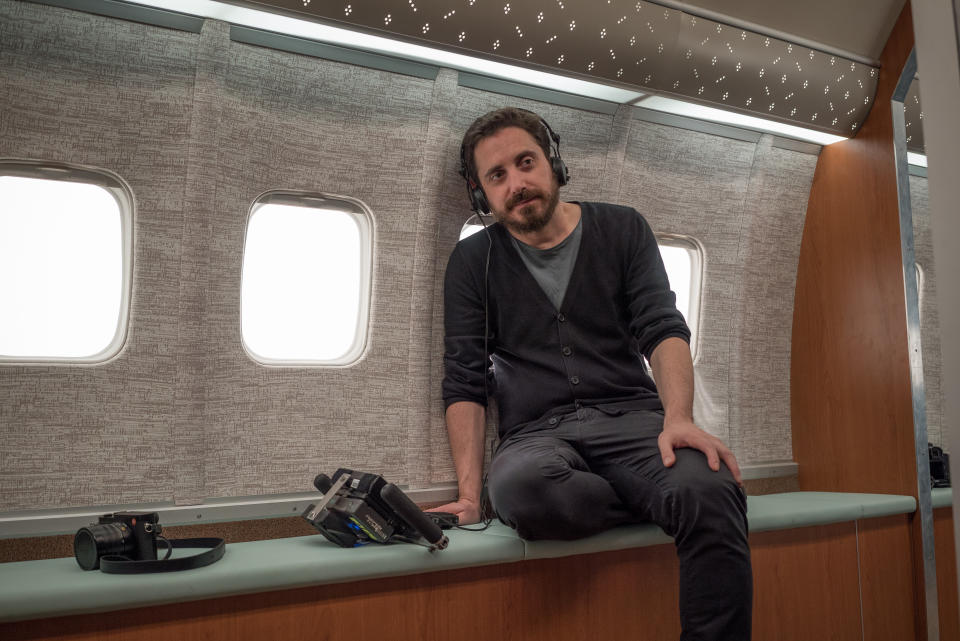‘Spencer’: Pablo Larraín on Reinventing Princess Diana with an ‘Upside Down Fairy Tale’

- Oops!Something went wrong.Please try again later.
- Oops!Something went wrong.Please try again later.
The most recent season of “The Crown” tackled the Princess Diana saga with Emma Corrin in the central role, but it should come as no surprise that it’s not the only recent effort to grapple with her legacy. In “Spencer,” Chilean director Pablo Larraín follows a transformative Kristen Stewart as the troubled princess on the weekend she decides to separate from Prince Charles. Yet Larraín’s film adopts a radical new approach to the ubiquitous character by reinventing her story — and giving her the last laugh, no matter what the history books say.
There are many reasons why Diana, otherwise known as Diana Spencer, continues to fascinate the public nearly 25 years after her death: The late member of the Royal family projected a powerful individualism at odds with the buttoned-up image of the regal world she married into and then rejected in public; her death is a tragic embodiment of the perils of modern-day fame; and she was ahead of the curve in light of more recent backlash to the Royal family’s oppressive regime.
More from IndieWire
Benedict Cumberbatch and Kristen Stewart Could Win Their First Oscars
'Sundown' Review: Michel Franco's Chiller 'New Order' Followup Is a Deadpan Existential Mystery
Yet “Spencer” avoids the many familiar paths to Diana’s legacy by taking serious liberties with her story and making no apologies for it. “We aren’t trying to explain who she was or answer questions on the larger scale of her life,” Larraín said in a phone interview from his native Santiago. “We’re fictionalizing most of it based on what we think could have happened.”
At first blush, that puts “Spencer” in the same league as Larraín’s Jacqueline Kennedy Onassis portrait “Jackie,” another tense and somber drama about a famous woman married into a powerful family who must chart her own path. However, Larraín said the catalyst for his new project came from a more personal place.
“Basically, I wanted to make a movie that Mom could like,” the filmmaker said, just a few days after locking picture ahead of the Venice premiere. The impulse arose as was looking at a photo of his mother when she was the same age as Diana at the height of her fame in the mid-‘90s. “Somehow, despite the enormous distances between these women, I always felt that my mother was very interested in this story, and was somehow influenced by her — like millions of people around the world,” Larraín said. “Then I wondered why Diana had created such a level of empathy. It’s a very complex answer.”
Which is not to say that “Spencer” aims for any firm conclusions. Instead, like much of Larraín’s work, the movie operates as an immersive and enigmatic character study built around the fierce determination of a character fighting to transcend her claustrophobic surroundings. Set at a Christmas gathering of the Royals at their vacation home in Sandringham House in Norfolk circa 1991, “Spencer” presents an imaginative vision of Diana as her grip on reality grows murkier and her frustrations with Royal traditions threaten to crush her resolve. Larraín’s approach blends Stewart’s measured performance with the precision of “Locke” writer Steven Knight’s screenplay and Johnny Greenwood’s frantic score. The result is an ominous chamber piece on the power of maternal instincts and the process through which a beleaguered woman cuts her own path.

Neon
“She was a regular woman trapped in a very unusual context,” Larraín said. “Even though she came from a very aristocratic environment and was close to the Royals, she became an icon of ordinary things.” A far cry from the historical precision of “The Crown,” Larraín’s approach embraces the opportunity to invent its own version of the character and the unknown circumstances that unfolded over the course of that fateful weekend. While keeping her distance from Charles (Jack Farthing), the Diana of “Spencer” oscillates from maintaining a protective demeanor over her two kids (Jack Nielen and Freddie Spry) and wrestling with the unnerving physical expectations imposed on her by ubiquitous rituals.
At times, that tension yields shocking flashes of body horror, such as when Diana imagines herself consuming the weighted pearl necklace she’s forced to wear at the dinner table, before attempting to puke it back up. Elsewhere, her mounting rebellion yields flashes of dark comedy (“I’m going to masturbate now,” she tells one doting servant, just to scare her off). As she begins to imagine the figure of Anne Boleyn (Amy Manson) creeping through the shadows, Stewart’s Diana begins to comprehend the malleable nature of her surroundings and bend them to her will.
Larrain said he and Knight “came up with this idea to create a sort of jailbreak movie, and an upside-down fairy tale. It’s how she’s connecting with herself, her youth, her past, and building her identity. The symbol of that is recovering her last name. It’s very simple but on a human level very complex.”
That approach gave them the liberty to discard any allegiance to historical accuracy. The movie opens with a credit announcing it as a “fable from a true tragedy” and runs wild from there. “The Royal family is very discreet and we don’t really know much about them,” Larraín said. “That provides a lot of room for fiction. You can read a lot about her, but there’s a point you have to stop or it can swallow you, paralyze you. When you’re doing a movie that has such a strong psychological perspective, you can never really research that.”
Instead, it was the concept of “Diana” that became a guiding principle in the quest to create a character more or less from scratch. “We only wanted to express a certain beautiful type of humanity,” Larraín said, “and then then show what happens when you expose it to the dangers of history and tradition.”

Neon
Those factors certainly invite comparisons to “Jackie,” Larraín’s first English language project, and the process he went through to bring Natalie Portman’s interpretation of the character to life. Larraín has mixed feelings about the comparison. “They’re both about key 20th century women linked to powerful families — and they both managed to have their own identities and deal with the media in a particular way,” he said. “But I think if ‘Jackie’ is about memory and grief, ‘Spencer’ is about identity and motherhood. It works in a different psychological spectrum, which leads to a different type of cinematic exercise.”
Larraín and his producing partner brother Juan de Dios first developed “Spencer” after they contacted British producer Paul Webster to gauge interest from a U.K. perspective, at which point they brought on German producers Jonas Dornbach, Janine Jackowski, and “Toni Erdmann” director Maren Ade from Komplizen Film (“Maren was quite helpful and generous throughout the process,” Larraín said). However, the project really took off when Larraín secured interest from Stewart, whom the director had been tracking ever since he saw her eerie turn in Olivier Assayas’ “Personal Shopper,” which deals with subjective perspective in similar ways. “There were many things she delivered that words cannot describe,” Larraín said. “That’s where cinema starts to operate.”
While it may seem to odd at first to watch Stewart adopt British mannerisms and an accent unlike anything she’s done before — not to mention that coiffed blond look — Stewart worked overtime to confront the specific challenges at hand, with guidance from famed dialogue couch William Connicker. “She was never trying to mimic Diana,” Larraín said. “That’s where dangerous things start to happen. She created a character who can ride illusions in a very intimate and mysterious way. As an actress, she’s very difficult to read.”

Photo by Stephanie Branchu. © 2016 Twentieth Century Fox Film Corporation
Larraín produced most of the set photos himself, and said that there was one key moment after Stewart finished makeup and hair where he felt like she had fully become the character. “Once she was confident with the accent and all the sort of practical verbal issues, she became a poetic combination of herself and Diana,” he said. “I don’t know what most people see in Kristen, but I see someone who was able to find the physicality and style of the great actresses of ‘50s and ‘60s. We felt like we were looking at an old-school type of performance in the best possible way. We just couldn’t stop admiring what she was doing.”
Larraín embarked on “Spencer” not long after his Apple-produced Stephen King adaptation “Lisey’s Story,” and embraced the opportunity to work on a much smaller scale for “Spencer,” which almost exclusively takes place in a single location. “I thought it was just better to minimize the audiovisual fireworks and just be there with her,” Larraín said. Working with cinematographer Claire Mathon (“Portrait of a Lady on Fire”), he developed an absorbing visual style by shooting primarily on 16mm film and relying on medium wide angle shots. That meant the camera was constantly in Stewart’s face as she roamed the cavernous hallways of the regal set. “I witnessed an incredible connection between Kristen and Claire,” Larraín said. “They were literally dancing — the camera and the character. It was just so beautiful to see.”
In the meantime, Greenwood started to send Larraín tidbits of the movie’s throbbing score, which in turn informed creative decisions on set. “He combined baroque music with jazz, which was very unusual,” Larraín said. “When he said that he wanted to do that, I didn’t understand how he could, but because it’s him, I said sure. So he sent this incredible texture of music from different eras and tones. When we started to put it together, the movie came up with this very particular identity.”

YouTube/screenshot
Stewart signed on for “Spencer” a few months before the latest season of “The Crown” hit Netflix last fall. Larraín shrugged off comparisons between the show and his own approach. “I’ve seen every episode of ‘The Crown’ not only for this movie but because I like it,” he said. “It’s very good television. Peter Morgan and his team really know what they’re doing. I really respect and admire that. But the way we approach similar historical materials and the humanity of these characters is just different.”
Another point of comparison arose during the shoot earlier this year, when Prince Harry and Meghan Markle did an explosive interview with Oprah Winfrey exposing their rift with the Royal family and accusing key members of racism, as well as the same oppressive behavior that was once imposed on Diana. “There’s a lot going on in the Royal family right now and I’m not the person who can draw any conclusions about it,” Larraín said. “The audience can do that for themselves. I can say that I have enormous respect for William and Harry. When I look at them, I remember Diana and that she was a mother above all else.”
While conversations may about the systematic problems with the Royals may enshroud “Spencer,” the movie has a broader connection to Larraín’s work going back to his earlier movies on Chile’s Pinochet dictatorship — “Tony Manero,” “Post Mortem,” and the Oscar-nominated “No.” Once again, he has wielded an embellished approach to systematic abuse. “I am dedicated in my work to understanding the logic of power and what makes it so absurd,” he said. “You see this incredible structure based on class and aristocracy built across hundreds of years, and when you look at it closely, there are so many absurd, fascinating things about it.”
As with the protagonist of “Jackie,” the Diana in “Spencer” is on a mission to rescue herself and her children. “Diana created such a level of empathy because she was just normal and smiled in this organic way in a world where most of the things we see feel fake,” Larraín said.
Back on the subject of mothers, he said he was working on finishing up a version of the movie with Spanish subtitles so his original source of inspiration could take a look. “I’ve made some movies that were too harsh for my mother,” he said. “I hope this one will be different. This movie is a testimony to her and to all mothers — but I can only think about my own reality and remember how lucky I am that I still have her.”
“Spencer” premieres in competition at the 2021 Venice Film Festival. Neon/Topic releases it in the United States on November 5, 2021.
Best of IndieWire
Sign up for Indiewire's Newsletter. For the latest news, follow us on Facebook, Twitter, and Instagram.

